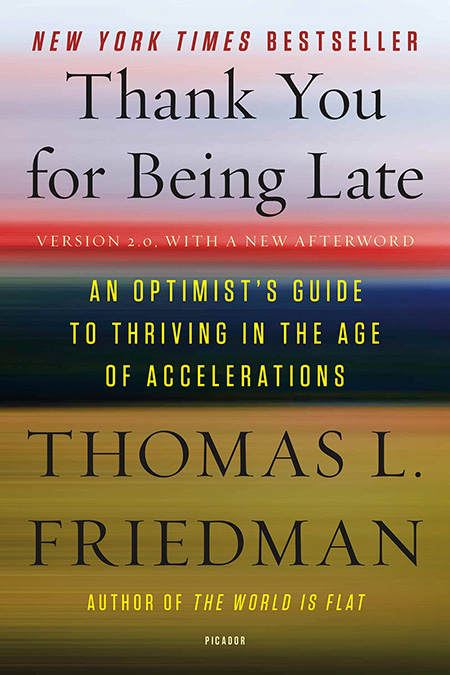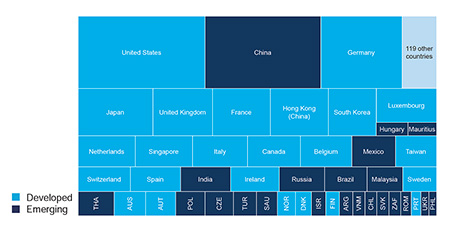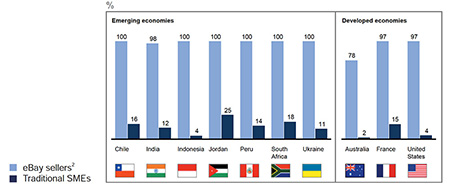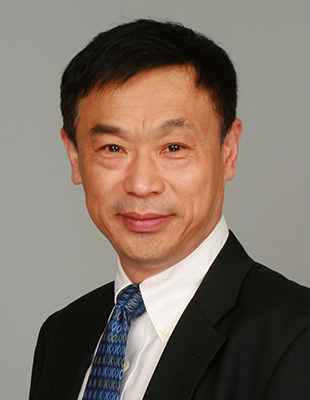This issue of City Business Magazine discusses big data and information & communication technology and their applications in marketing. Various articles explore from their unique perspectives the threats and opportunities brought forth by information and communication technology in business education and research. Intriguingly, these articles remind me of one of my favourite recent reads, Thomas Friedman's book Thank You for Being Late: An Optimist's Guide to Thriving in the Age of Accelerations. Thanks to his long-time experience as a journalist and his professional insight, Friedman is able to collate and summarise first-hand information. Moreover, as an award-winning journalist and bestselling author, his reputation and network allow him to interview top talents from industry, exploring the latest developments and trends of new technologies and their impact on business operations, which provide him with extraordinary insights and unique angle.
Friedman cites Google X Director of New Products, Astro Teller, on the relationship between the rate of technology progression and mankind's learning ability and environmental adaptability Teller asserts that in the past few millennia, the curve of science and technology development was close to linear. It took several centuries for a technology to progress from invention to reaching its full application, as seen in the cases of printing and explosives. Over the past hundred years, the pace of science and technology advancement has grown ever faster and there have been major breakthroughs every 20 to 30 years. A new technology now only takes 5-7 years to become widely adopted, and the speed of technology pick-up is still on the rise. A millennium ago, it took one or two generations to get adapted to a new technology. Now it takes only 10-15 years. In the face of such rapid technological advancement, more than ever people need to strengthen their learning ability in adopting and renewing technology.
I would draw a loose association between this and the trend of senior mainland business executives actively participating in learning, especially in pursuing various higher degree studies. This may be one of the reasons for the rapid growth of the Chinese economy over the last 40 years.
Two Thousand and Seven
Friedman rightly points out that 2007 was a pivotal year in technological advancement and big data commercialisation. 2007 saw the launch of a series of products and platform technologies that have had a profound impact on the big data era, including the first smart phone and Hadoop, an open-source software framework based on cloud-computing. Hadoop was developed based on Google's two innovations, Google File System (first released in 2003) and its distributed computing platform MapReduce (2004). Thanks to Google sharing its innovations with the public, Hadoop is not only a reimplementation in the public domain supporting massive data storage using cheap storage devices to process massive amounts of data in clusters of cheap computers using parallel processing, but also offers a full set of database management and storage retrieval methodologies, and monitors the communications between computing nodes. Moreover, designed with the fundamental assumption that hardware failures are common occurrences, the framework handles any failure detected on an individual node by re-directing the task to another node for computing. This open-source computing platform is an enabler for big data analysis happening anywhere on the web, not just for the big corporate players.
With the continued innovation and enhancement of Hadoop and GitHub, an open-source software development platform, we have seen a string of new technology companies launched onto the market. Moreover, major players such as Facebook, Twitter, LinkedIn, Alibaba, Tencent have used Hadoop for data storage and processing. Another important contribution that Hadoop made is that it has changed how most technology companies store and use unstructured data. Before Hadoop, almost all enterprises used systems such as the Oracle relational database and search language such as Structured Query Language to store, manage and make enquiries on their databases. For an SQL command to function, it needs to be certain about the database structure which is established well before the data is stored. The early versions of SQL were much constrained by processing speed and storage issues. Programmers had to make a lot of enhancements in designing the database structure in order to store, read and compute the data at faster speeds. Hadoop was a response to these issues, being sufficiently flexible that the database structure is only established at the time that the system starts reading the data.
Volume, Velocity, Variety, Veracity
Big data is often characterised by its 4V features: Volume – the size of the dataset, Velocity – the speed of data volume increase, Variety – the types of data, such as text, graphics, voice, video, clickstream, and Veracity – trustworthiness of the data. While volume and velocity are well known issues, the variety feature highlights the transition of structured data to unstructured data in the big data era. Structured data storage and processing on traditional relational database has made substantial development up to this day. However, the emergence of unstructured databases is now the dominant trend, not only because of their flexibility, but also because the growth rate of unstructured data far outruns that of structured data. Lastly, veracity refers to the reliability, accuracy and timeliness of data, and has been the biggest challenge for big data analysis which is often hampered by the unreliability, uncertainty and inconsistency of data sources and is subject to user bias. Hadoop has been an efficient solution in handling the first 3V's of big data. To adequately overcome the challenges from the last V, there is still much to be explored and discovered by statistical researchers in this emerging research area.
It is worth noting that the use of big data is mostly employed in developed countries and regions. A recent survey by Mckinsey on Global flows in the digital age reveals a preview of data mobility in various countries and regions around the globe. The United States, China and Germany are the top three countries in data usage and transfer. Hong Kong lies within the second tier at a comparable level with Japan and South Korea. However, if we consider the Greater China area as a whole, we are leading an upward trajectory in data use. Small and medium enterprises are found to benefit the most from this technology innovation.
Mckinsey's earlier report “Internet Matters: The Net's Sweeping Impact on Growth, Jobs Prosperity� (May 2011), pointed out that internet technology had increased the import-export turnover of small and medium enterprises two-fold, and in its recent report emphasises that ICT technology may play a vital role for SMEs in developing countries. For example, SMEs in Chile are trading with around three foreign countries through traditional channels. However, SMEs that go online trade with as many as 28 countries on average.
New Economy, New Public Financing, New Trends
As Friedman's book provides a detailed description of the rapid advances of information technology and the societal and environmental challenges that it poses, my interest was aroused to get to know more about this important trend. We were very fortunate to have Dr Shusong Ba, Chief China Economist of the Hong Kong Exchanges, give a keynote speech on “New Economy, New Public Financing, New Trends� at the Kick-off Ceremony of the EMBA+MPA programmes in collaboration with Tsinghua University in August. In his speech, Dr Ba introduced three major initiatives to be launched by the Hong Kong Exchanges: simplify the listing eligibility guidelines for biotech issuers, permit listings of companies with weighted voting right structures, and establish a new concessionary secondary listing route for Greater China and international companies. Dr Ba stressed that the capital market is a seedbed for incubating new startups, and further elaborated that the investment figures of European and US capital markets in ICT and biomedical companies took up as much as 73% of all capital investment in the US and close to 50% in Europe.
The vast majority of knowledge-intensive inflows and outflows occur in developed economies
Total knowledge-intensive inflows and outflows, 20121
Relative area corresponds to the portion of global inflows/outflows
1. A knowledge-intensive flow is a flow with embedded information, ideas, or expertise that is transferred when exchanged. Foreign direct investment is classed as a knowledge-intensive flow because it often entails the transfer of embedded ideas, management expertise, and technology.
SOURCE: Comtrade; IMF Balance of Payments; McKinsey Global Institute analysis
Online platforms enable businesses to attain global reach that comparable offline businesses have not achieved
Share of eBay commercial sellers and offline SMEs1 that export, 2012
1. Small and medium-sized enterprises.
2. eBay sellers are defined as a commercial seller with sales of over $10,000.
SOURCE: Enterprise Surveys, World Bank, 2012; Australia Bureau of Statistics, 2012, 2007; eBay; McKinsey Global Institute analysis
Exhibits from “Global flows in a digital age: How trade, finance, people, and data connect the world economyâ€�, April 2014, McKinsey Global Institute, www.mckinsey.com. Copyright © 2018 McKinsey & Company. All rights reserved. Reprinted by permission
Biomedicine, Hong Kong and Greater Bay Area
Dr Ba also shared an interesting observation on the locations of mainland enterprises listed in Hong Kong. Dr Ba noticed that Beijing, Shanghai and Guangzhou, the mainland cities with the highest numbers of companies listed in Hong Kong, all have a strong core in biomedical research. Two other leading cities, Shenzhen and Hangzhou, are more focused on ICT. This observation may be a morale booster for Hong Kong, revealing a win-win situation. On the one hand, Hong Kong houses world-class medical schools and maintains an efficient hospital system, as well as a state-of-the-art veterinary school newly established at CityU. On the other hand, Shenzhen is well known for its ICT innovations, and can complement Hong Kong. Thinking out of the box, biomedicine may be a new and unique area for Hong Kong to contribute to the development of the Greater Bay Area.
21 Lessons for the 21st Century
I guess Dr Ba's good intention is to draw Hong Kong people's notice to the importance of the biomedical industry, and also his high expectations of Hong Kong's medical schools and hospital system. In relation to this area, Yuval Noah Harari's new book 21 Lessons for the 21st Century may be a good supplement to Friedman's. Unlike Thank You for Being Late, which has a relatively limited coverage on biomedical technology and the integration of ICT with other technologies, 21 Lessons for the 21st Century regards technology, environment and nuclear wars as the greatest challenges in the contemporary world.
Harari's book stresses the importance of integration between ICT and bioscience technology, and describes it as an interesting and interactive interplay. As an historian, Harari points out that land was the most important resource over the past few thousand years, machinery for the past 200 years, and people have learned from past practice how to manage land and machinery. However, it is foreseen that the integration of ICT and bioscience technology is going to make profound impacts on mankind in the present day and the near future. Data on people will bring great changes to the development of human beings. Take this a step further, the one who owns people's data owns resources. Harari opines that humans are good at conducting projects, but they are not fully aware of the outcomes of their projects. He uses dam building as an example. Humans started building dams several thousand years ago. We are now building bigger dams and building them at a faster pace. However, we do not know how these dams are going to affect the environment and the climate.
Opportunities and challenges
In this big data era, it is important that we know more about data. Apart from the need for high performance computer systems and artificial intelligence technology to harness data, we need to understand the rapid growth rate and duplicability of data. These have important bearings on data management. Apart from learning the latest data technology, our coming generations need to fully understand how data technology may impact on the economy, society and individuals. CityU College of Business well acknowledges the opportunities and challenges that data technology brings to business education and research. In recent years, the College has introduced two new undergraduate streams, Computational Finance and Financial Technology. Both curricular are highly inter-disciplinary, covering extensive training in computer science, data analytics and statistics. The College plans to introduce courses from these streams to all our undergraduate students. We intend that our students be fully prepared for the challenges and opportunities of new data technology in business and the economy.
Professor Houmin Yan
Dean of College of Business





